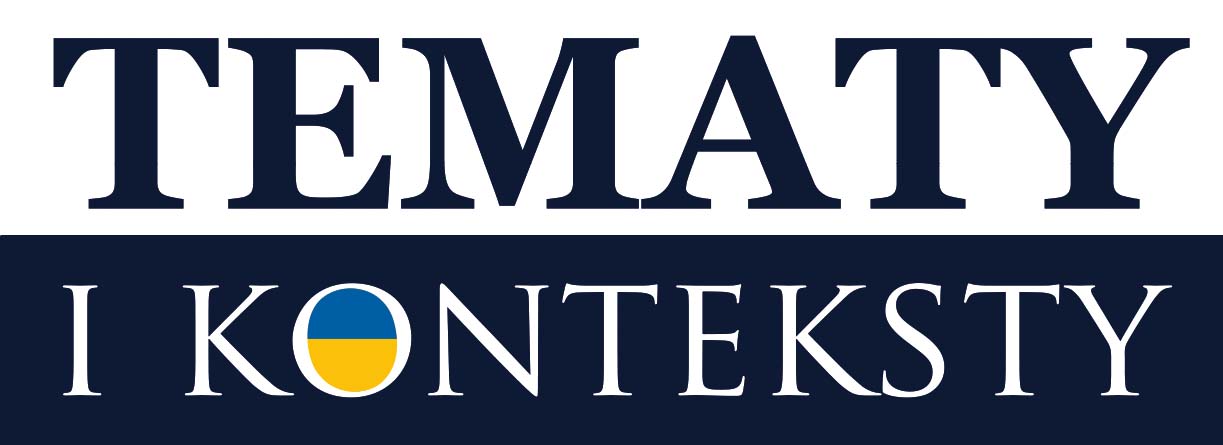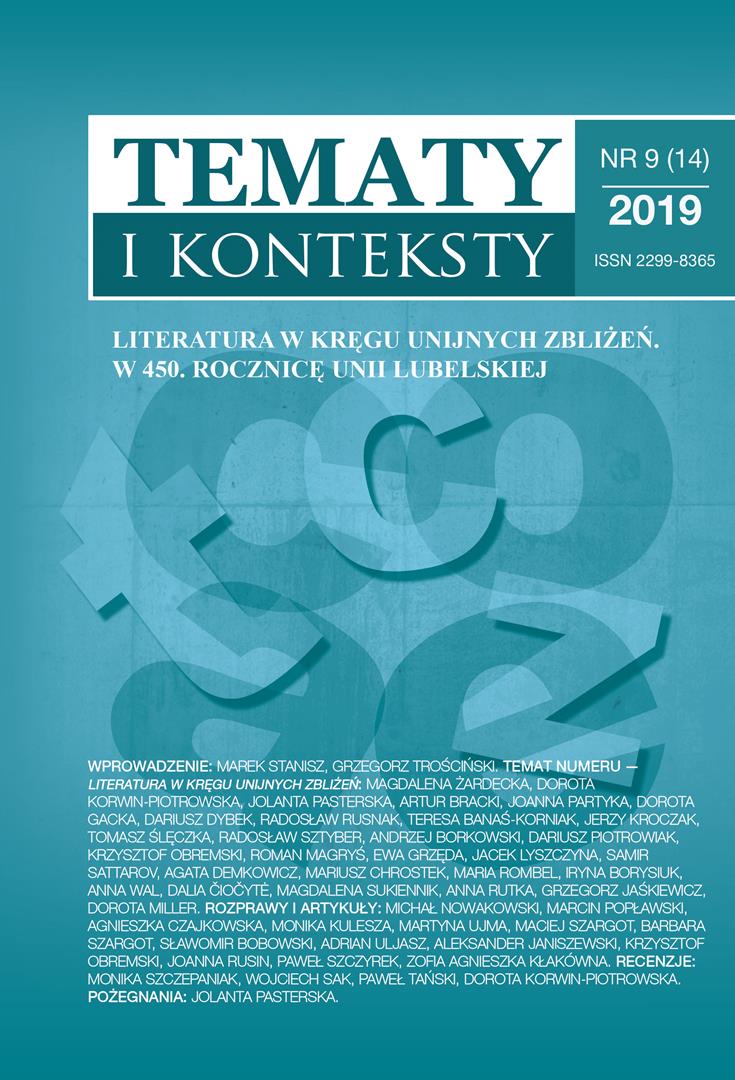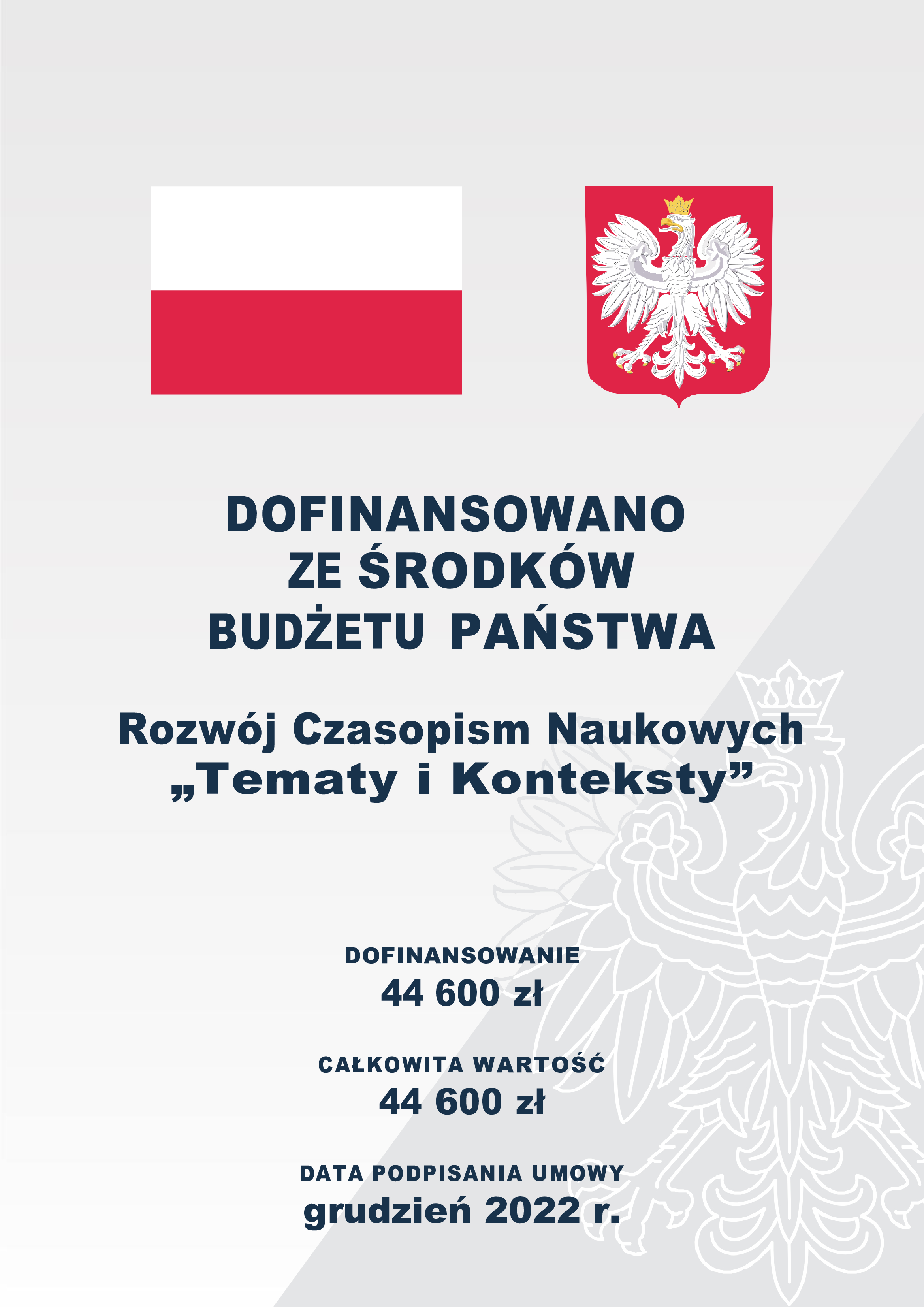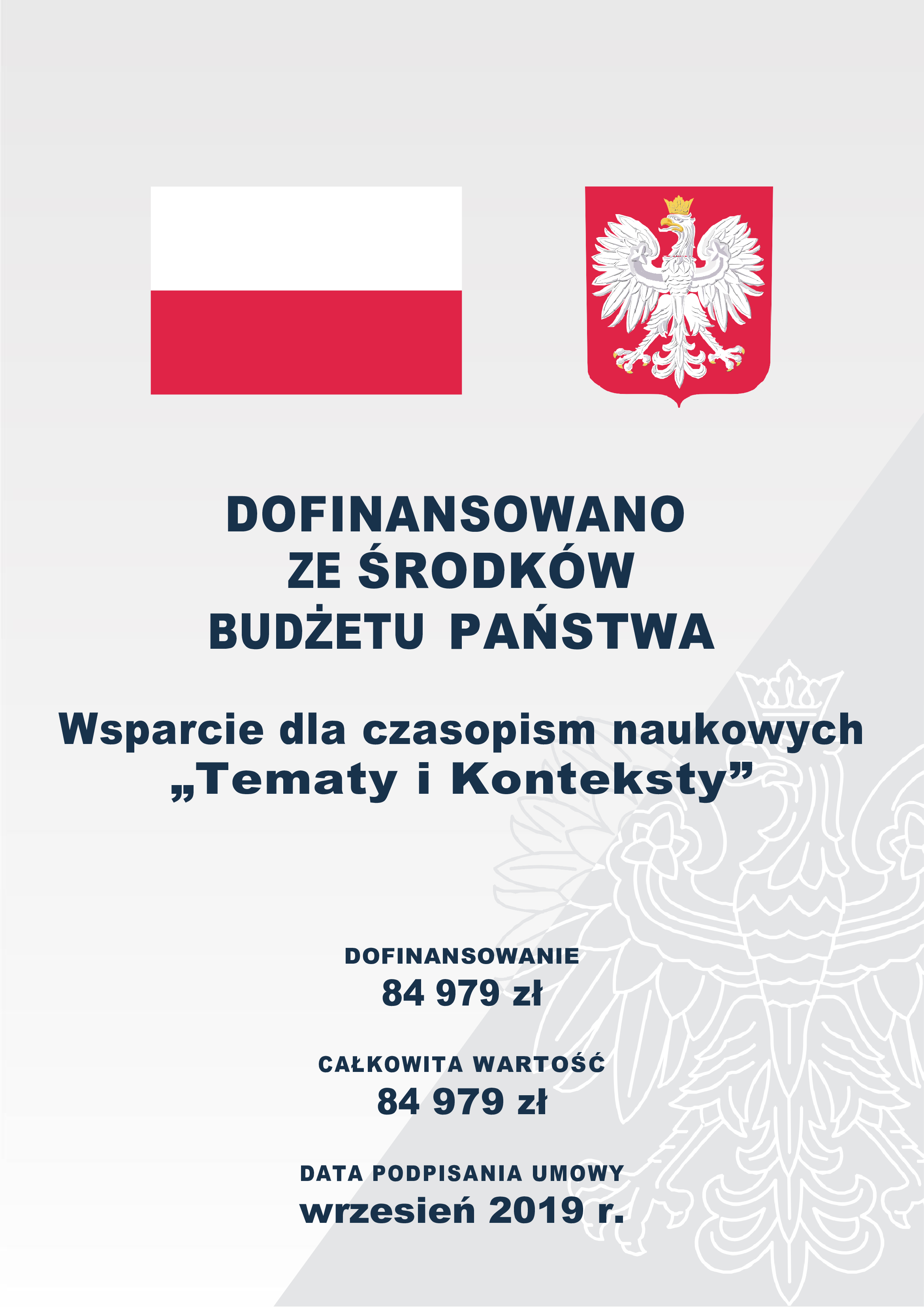Brex and the City. Kulturowe odwołania do brytyjskiegoreferendum w sprawie wyjścia z UE w prasie brytyjskiej, polskiej i niemieckiej
DOI:
https://doi.org/10.15584/tik.2019.30Słowa kluczowe:
odniesienia kulturowe, intertekstualność, Brexit, mass mediaAbstrakt
Idee wytwarzane przez społeczeństwo można prześledzić w poszczególnych tekstach lub grupach tekstów, zwłaszcza w tekstach medialnych powszechnie uznawanych za „[...] momenty, w których większe struktury społeczne i polityczne w kulturze są poddane analizie” (Turner 1996: 88). Ten nierozerwalny związek między mediami i kulturą we współczesnych społeczeństwach znajduje odzwierciedlenie na interdyscyplinarnym polu badań, znanym jako studium kultury medialnej (por. Kellner 1995), Medienkulturwissenschaft (por. Schmidt 2003) czy kulturoznawcze medioznawstwo (Gwóźdź 2008). Następnie na pierwszy plan wysuwają się przykłady wewnątrzkulturowej i międzykulturowej intertekstualności w brytyjskich, niemieckich i polskich artykułach prasowych związanych z Brexitem.
Downloads
Bibliografia
Allen, G. 2011. Intertextuality. London/New York: Routledge
Beaugrande, R. de and Dressler, W. 1994. Introduction to Text Linguistics. London/New York: Longman.
Bell, A. 1996. The Language of News Media. Oxford: Blackwell Publishers.
Burger, H. and M. Luginbühl 2014. Mediensprache. Eine Einführung in Sprache und Kommunikationsformen der Massenmedien. Berlin/Boston: de Gruyter.
Fairclough, N. 1995. Critical discourse analysis: the critical study of language. London and New York: Longman.
Fokkema, D. 2004. The Rise of Cross-Cultural Intertextuality. In: Canadian Review of Comparative Literature. Vol 31, No 1 (2004), pp. 5–10.
Grochala, B. 2002. Intertekstualność w nagłówkach „Gazety Wyborczej”. In: K. Michalewski (ed.) Tekst w mediach. Łódź: Wydawnictwo Uniwersytetu Łódzkiego, pp. 222–238.
Gwóźdź, A. 2008. O pewnym możliwym aliansie, czyli w stronę medioznawstwa jako kulturoznawstwa. In: Kultura współczesna 2/2008, pp. 204–213.
Hepp, A., S. Hjarvard and K. Lundby (2015) Mediatization: Theorizing the Interplay between Media, Culture and Society. In: Media Culture & Society, pp. 1–11.
Hiramoto, M. and J. S. Y. Park 2010. Media Intertextualities. Semiotic mediation across time and space. In: Pragmatics and Society 1:2, pp. 179–188.
Holthuis, S. 1993. Intertextualität. Aspekte einer rezeptionsorientierten Konzeption. Tübingen: Stauffenburg.
Hutcheon, L. 2006. A Theory of Adaptation. New York/London: Routledge.
Jakobs, E.-M. 1999. Textvernetzung in den Wissenschaften. Zitat und Verweis als Ergebnis rezeptiven, reproduktiven und produktiven Handelns. Tübingen: Niemeyer.
Janich, N. 1999. Werbesprache. Ein Arbeitsbuch. Tübingen: Gunter Narr.
Janich, N. 2008. Intertextualität und Text(sorten)vernetzung. In: N. Janich (eds.) Textlinguistik. 15 Einführungen. Tübingen: Gunter Narr, pp. 177–196.
Kacprzak, A. 2002. Palimpsesty słowne w języku mediów. In: K. Michalewski (ed.) Tekst w mediach. Łódź: Wydawnictwo Uniwersytetu Łódzkiego, pp. 46–52.
Kellner, D. 1995. Media Culture: Cultural Studies, Identity and Politics Between the Modern and the Postmodern, Routledge: London/NY
Klein, J. and U. Fix (eds.) 1997. Textbeziehungen. Linguistische und literaturwissenschaftliche Beiträge zur Intertextualität. Tübingen: Stauffenburg.
Kristeva, J. 1980. Desire in Language: A Semiotic Approach to Literature and Art. New York: Columbia University Press.
Markiewicz, H. 1988. Odmiany intertekstualności. In: Ruch Literacki 4–5, pp. 245–263.
Mazur, J., A. Małyska and K. Sobstyl (eds.) 2010. Intertekstualność we współczesnej komunikacji językowej. Lublin: Wydawnictwo Uniwersytetu Marii Curie-Skłodowskiej.
Meinhof, U. H. and J. M. Smith 2000. Intertextuality and the Media: From Genre to Everyday Life, Manchester University Press.
Newmark, P. 1988. A Textbook of Translation. New York: Prentice Hall.
Nord, Ch. 1997. Translating as a Purposeful Activity. Functionalist Approaches Explained. Manchester: St Jerome.
Nycz, R. 1995. Tekstowy świat: poststrukturalizm a wiedza o literaturze. Warszawa: Instytut Badań Literackich PAN.
Opiłowski, R. 2006. Intertextualität in der Werbung der Printmedien. Eine Werbestrategie in linguistisch-semiotischer Forschungsperspektive. Frankfurt am Main: Peter Lang.
Opiłowski, R. 2015. Der multimodale Text aus kontrastiver Sicht. Textdesign und Sprache-Bild-Beziehung in deutschen und polnischen Pressetexten. Wrocław – Dresden: Atut / Neisse Verlag.
Orr, M. 2003, Intertextuality: debates and contexts. Cambridge: Polity.
Ott, B. and C. Walter. 2000. Intertextuality: Interpretive Practice and Textual Strategy. In: Critical Studies in Media Communication Vol. 17, No. 4, pp. 429–446.
Pfister, M. 1985. Konzepte der Intertextualität. In: U. Broich and M. Pfister (eds.) Intertextualität. Formen, Funktionen, anglistische Fallstudien. Tübingen: Niemeyer, pp. 1–30.
Schmidt S. J. 2003. Medienkulturwissenschaft. In: A. Nünning and V. Nünning (eds.) Konzepte der Kulturwissenschaften. Stuttgart / Weimar: Metzler, pp. 351–370.
Smadja, F. 1994. Retrieving collocations from text: Xtract. In: S. Armstrong (ed.) Using large corpora. Cambridge/London: The MIT Press, pp. 143–178.
Steyer, K. 1997. Irgendwie hängt alles mit allem zusammen – Grenzen und Möglichkeiten einer linguistischen Kategorie ‚Intertextualität‘. In: J. Klein and U. Fix (eds.) Textbeziehungen. Linguistische und literaturwissenschaftliche Beiträge zur Intertextualität. Tübingen: Stauffenburg, pp. 83–106.
Stöckl, H. 2004. Die Sprache im Bild – Das Bild in der Sprache. Zur Verknüpfung von Sprache und Bild im massenmedialen Text. Konzepte. Theorien. Analysemethoden. Berlin/ New York: de Gruyter.
Tegtmeyer, H. 1997. Der Begriff der Intertextualität und seine Fassungen – Eine Kritik der Intertextualitätskonzepte Julia Kristevas und Susanne Holthuis’. In: J. Klein and U. Fix (eds.) Textbeziehungen. Linguistische und literaturwissenschaftliche Beiträge zur Intertextualität. Tübingen: Stauffenburg, pp. 49–81.
Turner, G. 1996. British Cultural Studies. An Introduction. Routledge: London and NY.
Wodak, R. 2001. What CDA is about – a summary of its history, important concepts and its developments. In: R. Wodak and M. Meyer (eds.) Methods of critical discourse analysis. London, Thousand Oaks, Delhi: Sage Publications, pp. 1–13.
Zuschlag, Ch. 2006. Auf dem Weg zu einer Theorie der Interikonizität. In: Horstkotte, S. and K. Leonhard (eds) Lesen ist wie Sehen: intermediale Zitate in Bild und Text, Köln, pp. 89–99.
Zuschlag, Ch. 2012. „Die Kopie ist das Original“: über Appropriation Art. In: Mensger, A. (ed.) Déjà-vu? Die Kunst der Wiederholung von Dürer bis YouTube. Karlsruhe, pp. 126–135.
Cambridge Dictionary: https://dictionary.cambridge.org/
European Journalist Centre: https://ejc.net/
Longman Dictionary of Contemporary English Online: https://www.ldoceonline.com/
Press Gazette: http://www.pressgazette.co.uk/
The Free Dictionary: https://www.thefreedictionary.com/
Wielki Słownik Języka Polskiego: http://www.wsjp.pl/
Wikipedia: https://en.wikipedia.org/wiki/Main_Page
Wikipedia: https://pl.wikipedia.org/wiki/Wikipedia:Strona_g%C5%82%C3%B3wnaWikisłownik: https://pl.wiktionary.org/wiki/Wikis%C5%82ownik:Strona_g%C5%82%C3%B3wna
Pobrania
Opublikowane
Jak cytować
Numer
Dział
Licencja
Prawa autorskie (c) 2019 Tematy i Konteksty

Utwór dostępny jest na licencji Creative Commons Uznanie autorstwa – Użycie niekomercyjne – Bez utworów zależnych 4.0 Międzynarodowe.




